Only 92 more and I’m done :)
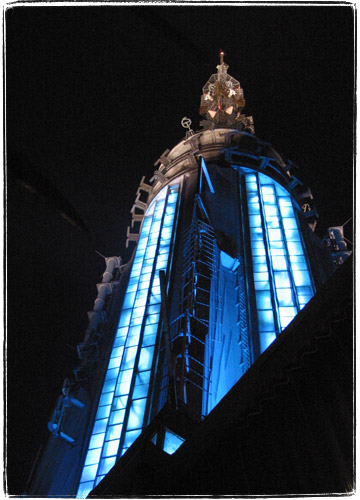
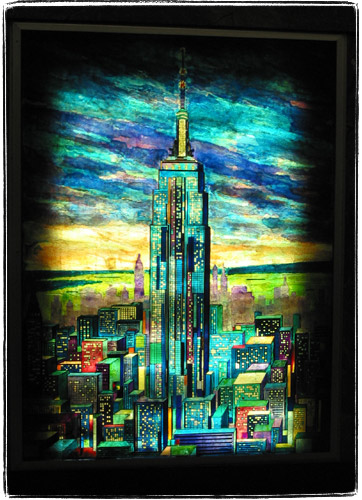
Rock Center At Night
Group portrait of the newer, uglier Rockefeller Center buildings: Newscorp Building, McGraw Hill Building and Exxon Building.

Jewelry district with the view of the illuminated glass crown of the Bear Stearns Building. The crown houses machinery and water tanks.
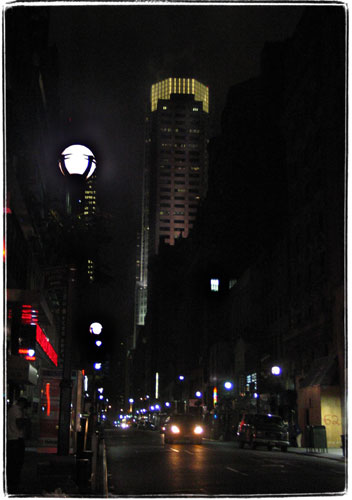
Wheeee.
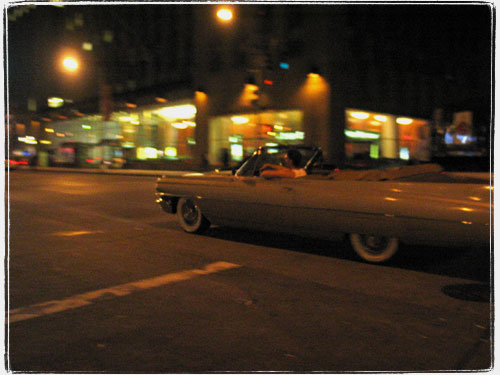
For some weird reason green traffic light turns blue on my photographs.
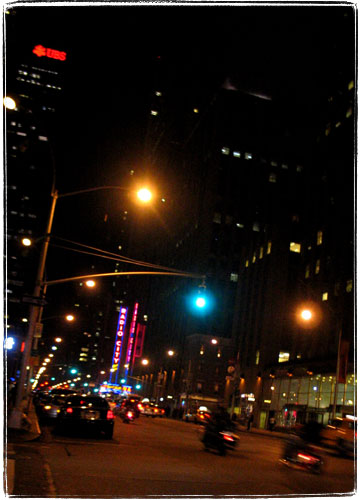
One Hundred Views Of Empire State
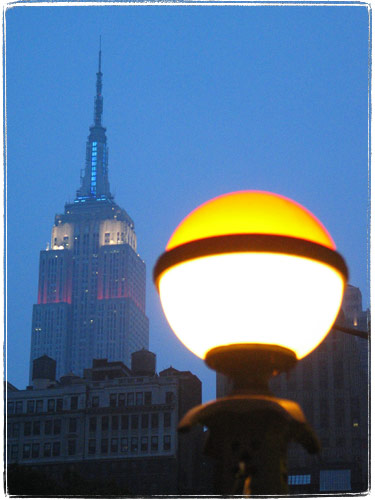
So I was buying overpriced fotoclips at the photography museum shop. Then I decided to buy a few postcards for sending to my non-writing friends. The only one New York picture I liked half way was the one on Empire State Building with the subway globe. But then I quickly remembered the globe itself was half a block from where I was. So there it is. Zero creativity, 100% cliche. Saved 75 cents.
Auto Moto Velo Photo
My two favorite photography books about New York are David Bradford’s Drive by Shootings : Photographs by a New York Taxi Driver and Harvey Wang’s New York.
You might have noticed a decorative border that I almost always put around my photographs. I first seen it in Harvey Wang’s book. I asked my photography professor in college about how that effect was achieved. She explained to me that Wang took his negative holder and filed down the edges. This projected not only the picture from the negative, but also a little bit of the edge and film sprockets onto the paper. Besides looking cool and framing the picture nicely this also was a way of showing off – this shows that none of his photographs were cropped. It’s like he was saying – look, my framing is perfect, cropping is for wussies. I am a wussie. I crop like there is no tomorrow. And since I am only using digital these days, I rely on a Photoshop plugin called Extensis Photoframe.
Dead Programmer On Coffee
You see, this dude Schomer served in the Army as a metrologist. No, not a meteorologist. A metrologist, a person who measures stuff for a living. When he became a civilian again he decided to apply some of his skills to making espresso.
Good espresso is very hard to make. It’s no secret, really. And it’s rather well known what you need to do to make good espresso. To oversimplify things you need:
a) very fresh, properly roasted high quality coffee beans
b) pure water with a certain degree of hardness
c) a good quality burr grinder with very fine grind adjustment
d) a La Marzocco espresso maker with perfectly adjusted for water temperature and pressure
e) a perfectly fitted espresso tamper (such as one made by Reg Barber)
f) a thick walled ceramic cup
and
g) a barrista who knows what he or she is doing.
Now, the barrista must be able to do the following things:
a) correctly adjust the grinder and grind enough beans for one shot. This is a tricky trial and error process – the grinder must be adjusted depending on ambient temperature and humidity.
b) fill the portafilter very evenly with the correct amount of coffee grinds and tamp them down with enough force
d) make sure that the group doesn’t have enough time to cool down
e) place the group into the machine and press the brew button, shutting it off after a correct period of time
f) judge the quality of the resulting espresso shot and throw it out and make a new one if it’s no good
g) keep the machine in immaculate state of cleanliness
All of these steps are important. David Schomer came up with a way to measure and reduce already small temperature fluctuations in La Marzocco machines. He also added extra cooling fans to his grinders to prevent coffee from heating up when ground. He custom made ergonomic perfectly fitted tampers. He measured, modified hardware and technique and then measured again, sharing his secrets with the world.
Right now I am between espresso machines. When my last machine gave up the ghost (word to the wise, don’t buy any consumer grade Nuova Simonelli machines. If they die, you won’t be able to get any service for them) I decided to get nothing other than a used single group La Marzocco. I can’t afford a new one as it costs around 6 grand, but used ones can be had for as little as $1000. One of the problems is of course that it uses 220V electricity, but I’d be willing to pay an electrician to install a 220V outlet for me. Of course some lucky bustard got an experimental 110V machine, but no such luck for me. Besides, I want the real thing. I am horribly tempted to get an ECM Giotto machine that comes recommended by Schomer himself though…
Nah, I don’t want to leave New York just because there no good espresso places here. It’s cheaper just to make my own. Or even one day I might open the real Dead Programmer’s Cafe here. Maybe if I find a partner..
This all kind of reminds me – I am all out of coffee beens. Time to order some more.
Lunch Time Post I : Now, About That Lunch…
999
The scary thing about the newer Rockefeller center buildings is that from Times Square they look kind of like the perished World Trade Center towers. If you add outright “satanistic” “999 Pharmaceutical” and “DOG” ads and a jet plane trail, the picture becomes even scarier.
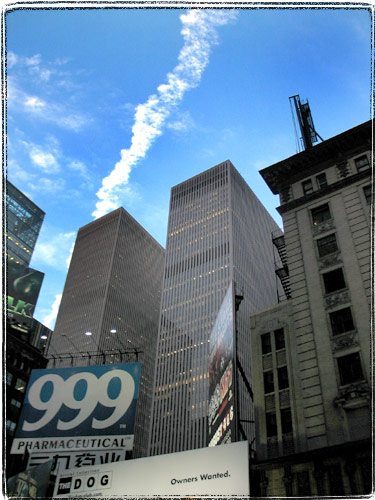
Nitrogen Breathing Nuclear Hobos From Beneath Gotham
One of the things I like to think about when walking around Manhattan is what’s going on underneath the streets of big cities. There are amazing things happening there. Take for instance this amazing story that
So I still had to sift through the mind numbing chatter of Usenet to find out what is the deal with those liquid nitrogen tanks that are very common in the streets of Manhattan.
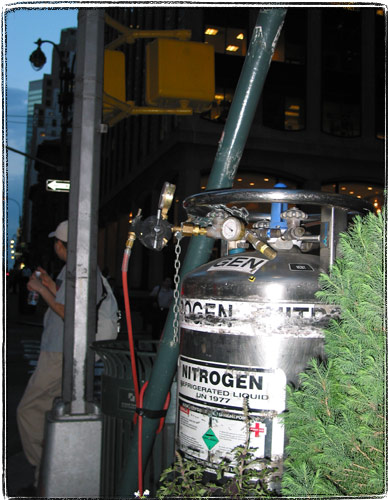
Apparently they use nitrogen to prevent underground fires and explosions. But who knows, there could be a race of nitrogen breathing creatures living there. Or it could be that city workers are making icecream down there.
Shaker and Baker or Gaudi, not Gaudy
When I was in my teens, I wanted to become an architect. I read books about architecture, and one of my favorite pastimes was trying to tell the architectural style of any buildings I saw. I did that in my native city of Odessa, Ukraine and on the trips to Moscow, Leningrad and Kiev. For a while I really favored the Gothic style. I really liked the soaring feeling of gothic churches. But then I’ve seen a rather plain building with rounded, yet also soaring shapes. The only decoration on the building were relief plaques. The building was rather old, yet depicted on the plaques were an airplane, a light bulb, a telegraph key and I think a radio. My dad explained to me about Art Deco style.
Here, in America, I learned about different art movements of the beginning of the century. It gets pretty complicated. There is Art Deco, Art Modern, Art Nouveau, Arts and Crafts and Shaker style. Why I like these styles? Well, it’s because I think that they have just the right proportion of beauty and utility. This is a sort of a mental cheat sheet that I have (embellished with links, of course):
Shaker Style: Shakers are a now mostly extinct religious sect. In fact they are a splinter of the Quaker movement, and were called shaking Quakers because their praying during which they shook. I can’t distinguish Shaker Style from Arts and Crafts, and indeed they are very similar. Genuine Shaker items are very expensive, but these days many manufacturers make shaker style furniture and kitchen cabinets. Although great designers and craftsmen, there are very few Shakers remaining. I bet it’s all because they are supposed to be celibate.
Arts and Crafts: Started in Great Britain. A bunch of designers and architects were pissed off by the poor quality and gaudiness of early mass produced things. Their motto was something to the tune of “turn artists into craftsmen and craftsmen into artists”. Simple bordering on austere designs, natural materials, muted colors, handmade look. The radically new idea was to take away most of decoration, but at the same time turn structural elements into decorations. Instead of hiding beams, supports, joins and other elements of construction, the designers would instead show them off. The solidity, strength are considered virtues. The proportions are usually more down to earth, not meant to dwarf a person. Think Frank Lloyd Wright and Newcomb College Pottery. Basically heavy duty, expensive hand made crap for rich people with good taste.
Art Nouveau: Started in France. The name is derived from the name of some gallery or exhibition or something like that. The idea was to create a whole new style for the new century. Just to be different. The designs are organic (meaning that things looked as if they were grown, not built), proportions – elongated. Not a single sharp edge to be seen. Think Aubrey Beardsley, Tiffany (who names their son Louis Comfort?), Gaudi and what he did in Barcelona. I would also call H.R. Ggiger’s stuff modern Art Nouveau, although I don’t know if that’s correct. In general a style for eccentric rich people.
Art Deco: Very similar to Arts and Crafts and Art Nouveau. The major difference is that instead of making things look hand made, the fact that things are made by machines now is celebrated. Elements of the design are very industrial, proportions – soaring. There is a wide variety in colors used – sometimes they are muted, even dark, sometimes – absolutely outrageous. Shining stainless steel is not out of place, and neither is polished black lacquer. Think Chrysler Building, Empire State Building and other New York skyscrapers, early Polaroid cameras, bakelite rotary phones (in fact anything made out of bakelite), cathedral radios, turn of the century cars.
The thing is, Art Deco is easily corrupted. There is a style that is sometimes derogatively referred to as “Bronx Modern” or “Flatbush Renaissance”. Gaudy, ugly stuff. Like much of Italian furniture sold in Brooklyn. Or like Joey Tribbiani’s apartment in “Friends”. Such perverted Art Deco is rather common. Do not confuse it with true, beautiful Art Deco.
Brazil… Where hearts were entertaining June
It’s not my fault that Buttle’s heart condition didn’t appear on Tuttle’s file!
NEW YORK (Reuters) — Police kicked down the wrong door at a New York apartment house on Friday and a woman with a heart condition died on the way to the hospital.
If you search for “Brazil” in google images, this is the first search result.
But I wanted to illustrate the story with this:

My favorite scene in the movie.